#shrek story analysis
Explore tagged Tumblr posts
Text
youtube
This might be the best video i dropped this year y'all.
#shrek#shrek analysis#shrek the third#shrek review#shrek and fiona#shrek story analysis#shrek 1#shrek forever after#shrek video essay#shrek 2001#shrek movie#shrek franchise#shrek discussion#human shrek#arcane season 2#arcane#arcane season 2 review#arcane season 2 reaction#arcane season 2 act 1#arcane season 2 act 2#arcane season 2 explained#arcane season 2 breakdown#arcane 2#arcane season 2 episode 1#arcane reaction#arcane season 2 episode 2#Youtube
6 notes
·
View notes
Note
Hi hi I wanted to ask for your deconstruction of Rhys. I love him to bits but I think it clouds my perspective and I would love an outside perspective on how to write him >.<
Hi!!
To start off, I am obviously not a professional, but i do have over 10 years of writing experience, and I like to think I’m pretty good! Take everything I say with a grain of salt, and I encourage you to come to some of your own conclusions as well :)
Splat, the co-owner of this account, has some things to say too! Rhys is one of his favorites, so he’ll tell you some things about him, and I’ll add some writing tips at the end.
Even though the choices you make can affect his personality in tales, there still is a lot of core features that remain the same through most, if not all playthroughs.
He's extremely loyal to his friends, it’s obvious that they're crucial to not only his arc but his characters, and he is quick to defend and help them to the best of his abilities.
Rhys does display fear in many situations in tales, especially in the starting episodes, but I believe he's a brave character. Despite being afraid, he moves forward regardless of that. If he WASN'T brave, he wouldn't have been able to brave some of Pandora's hardships. He's a lot more capable than people give him credit for.
He isn't without flaw, of course. he's ambitious, and he can be a real asshole. BUT, that doesn't erase the fact that he tries his best to be somewhat kind as well. The two statements can exist at once. We read a book analysis on the Borderlands franchise pre-bl3 that talked about how his masculinity is portrayed differently from most other boderlands men. (The book is called Ain’t No Place For a Hero, check it out.) It elaborates on the good in him, and despite starting out the story AS a "villian", he still has an actual heroic [kind, good, etc.] nature. As opposed to Jack, he is a foil in that way.
Rhys' is a very complex character, I don't blame people for having many interpertations. I think many of them can be good, and even I have some trouble writing him sometimes. Balancing out his core traits definitely helps, and not leaning too much into once of them can help lots.
-Splat
I concur!! lol
Anyway, they are right. The key to writing any canon character is to rewatch the series and take notes! Think about him as a 3D box instead of a 2D one. He has personality traits like ambition, yes, but there is always a reason for his ambition. He’s not just blindly like that- everyone was nurtured to act, or BE, a certain way
Is he a coward for being afraid of Vasquez, of Hyperion, or is he a brave guy for pushing through the fear to do what he believes he needs to do. Based off of that, you can keep expanding. He’s headstrong- he does what he needs to do because he BELIEVES he either deserves it, or it’s what he wants for him and his friends.
Speaking of his friends, at every turn in Tales, if you go what I consider to be the canon route (being that you refuse Jack at the end of the game) he chooses them over his end goal. This proves while he is headstrong- he’s not blind. He loves his friends, and is willing to sacrifice everything he ever wanted to keep them safe- which means he’s caring above being ambitious.
These are all personality traits you can pull from moments in the game. Your best friend when writing Rhys is to think of him as an onion. Yes, i’m quoting Shrek. He has layers- ambition and swagger on top- but when you peel it back, at his core, he does his best to do what he thinks is right (after leaving Hyperion).
Just keep in mind that every character does everything for a reason, and reread when you’re not sure you’ve done something right.
-Doglin
(and a good tip for writing dialogue is to repeat it with his voice in your head, and see if it sounds like him)
#borderlands#bl3#borderlands 2#tftbl#bl2#tales from the borderlands#rhys tftbl#debt or alive#handsome jack#borderlands debt or alive#tales from the borderlands is my lifeblood#writing#fandom
16 notes
·
View notes
Text
Vivit Characters if they had Letterboxd
by suggestion of a friend, because I put too much effort and wanted to post this
ASH: Super fucking dumb reviews. Makes hyperspecific lists (i.e. the shrek and get out one) and reviews based on how funny it'd be. Sometimes shes seen it. Sometimes she hasn't.
☆ ☆ ☆ ☆ ☆: Justice for the grinch, to be honest. He's literally just an anticapitalist victim of racism raised by two lesbian moms. He did nothing wrong.
☆: The only part I liked was when Morbius said its morbin time and morbed all over the place
MACK: RELIGIOUSLY leaves reviews for everything he's seen. He's super positive about every film, always seeing the strengths even when he doesn't like it. They're always super detailed too, usually a paragraph or two in length. All his reviews scale from 3 stars to 5. Only one movie has ever been given a one star review.
☆ ☆ ☆ ☆ ☆: I think this is my favorite film of the year :D To start off with the positives, the choreography for the dance scenes was very fun to watch and ... [read more]
☆: I can tell the writers tried to make this really informative! I'm not sure what their sources were, as everything is categorically wrong, but they tried! Here are links to every article that debunks this :o) ... [read more]
NERVA: Only leaves reviews for her hallmark binges. Her litmus scale is based on quality in relation to other hallmark films, and puts a note before every review that in relation to any other film, they would garner two stars at most, zero if it were possible.
☆ ☆ ☆ ☆ ☆: Surprised me. A hallmark movie has not done that since 2063. It was interesting she stayed with her New York City Boyfriend. Unexpected.
☆: Another copy-and-paste plot. The third act misunderstanding occurs at one hour and thirty-five minutes, as it does with every movie. The kiss happens twenty-six minutes later: A minute more than usual. This means I had to sit through an extra minute of this movie. Oh well.
SAMUEL: Only really updates it to say he has a letterboxd. Posts a review every so often when watching a film he enjoys, spending most of it rambling about his personal analysis than anything else. Oftentimes surprisingly good though.
☆ ☆ ☆ ☆ ☆: Another masterpiece from this director as always. No surprise there; with his nihilistic worldview, the character study of ... [read more]
☆: I came with an open mind. Regrettably, I'm disappointed. My child encouraged me to watch this, and though the low age demographic was a warning sign in itself, this truly exceeded my expectations in the worst way possible. To present this sorry excuse for a "story" to young impressionable minds ... [read more]
VIDA: Posts a review for every single movie they watch, and there's a lot. Like, one a week, at least. They post full essay length reviews, broken down into sections. They've got it down by a science. They also regularly make organizational lists based on tone or situational enjoyment. They have more 1 and 2 star reviews than not. They've unknowingly posted Mack's reviews off site to bully the shit out of them. Their meanest reviews are towards cliché "classical" movies, because that's what Samuel made them watch.
☆ ☆ ☆ ☆ ☆: Alright, let's not beat around the bush: This thing is great. I know everyone's like, "blah blah blah, this was going to be terrible" — but they were wrong, so eat shit. As always, we're dividing this between cinematography, writing, acting ... [read more]
☆: That's it. No fancy formatting because what the hell is this. I genuinely think the person who told me to watch this hates me, because if you enjoy THIS, you're braindead. Objectively braindead. Anyways, I want to meet who worked on the color grading for this so badly, because I am convinced they're COLOR-BLIND. Actually, is that offensive? Because color-blind people can still see values, right? And god, there is NO contrast in this garbage ... [read more]
AMATUS: Only gets into it because Vida suggested it. He has a lot of thoughts on films, but he prefers verbalizing them anyways. He doesn't care to influence peoples opinions much on this front, so he really just leaves objective reviews that are fairly short. Sometimes he does leave monster reviews if no one will entertain his thoughts, but thats few and far between (because Vida keeps goading him into rants always). Loves reviewing indie, arthouse films the most.
☆ ☆ ☆ ☆ ☆: This was enjoyable for both me and the group I watched this with :) If you're looking for a lighthearted comedy, I would highly reccomend.
☆: I think I was the wrong audience for this. I'm not sure who this movie is for, in that case, but maybe it's someone... Probably not.
4 notes
·
View notes
Note
I think at the end of the day “stolitz” is a product. It’s a carefully crafted mass appeal product. And a toy. They aren’t two characters with a deep love story, tear jerking kindness, and strong bond, they’re two dolls playing games with a lonely audience wearing blinders. The young queer audience starving for Disney content: but gay. That’s why their tolerance level is so high and their denial so high. It’s sad. But it just shows when people are starving they’ll eat anything. Even rot.
Stolitz is something that you are supposed to draw art of and then post online, write erotica about, project your own relationship fantasies onto, and insert any trope you can think of, “height difference” “class difference” “water element x fire element” “tsundere” “enemies to lovers” etc. And most importantly, buy from its mountain of merchandise.
Insert the two into all your other favourite stories: Rapunzel, Frozen, Hercules, Shrek. It’s designed between two different personalities and both are so shallow, they can be warped into any pair of characters and any ooc change can just be called “development.”
Vivienne medrano loves the fantasy of the two characters being in love, meant to be, happy, perfect for each other. Her stubborn pretense that she’s actually written a love story here, not horrific glorified rape and deep layers of toxicity and abuse, gives her self esteem. It owns the haters. Which is such a shame. She had a platform for an impactful story and message, and chose the most unchallenging, pro establishment anti-progress plot possible. If there weren’t millions of shippers, the story would never have become this.
This is all absolutely correct. Great analysis!
I want to expand a bit. I recently read an article about streaming services and the rise of passive content, or content you’re not supposed to watch. This is stuff designed to play because you forgot to turn off your TV after you finished watching what you actually wanted to watch. It’s content for the sake of content.
In this way, Vivziepop’s shows are a perfect reflection of this phenomenon. They are designed to create content: discussion, outrage, fan art, merchandise. It’s stuff whose primary purpose is to make more itself. It’s not meant to be consumed on its own or even consumed carefully.
I remember an early Hazbin Hotel trailer for Amazon had some title that read “From Viral Creator Vivienne Medrano” and I thought that was so insulting to her. But maybe that is the ultimate compliment.
2 notes
·
View notes
Text
Understanding Puss in Boot: The Last Wish through its villains (but mostly just Jack Horner)
By @terminatorbuns, with special thanks to my wife @da-manta-ray

We don't talk enough about the villains of Puss in Boots, the Last Wish. I mean we do, I just want to talk about it MORE.
It's been a while since this movie was released and I'm glad to see all the discussion and discourse around all the ways that this movie has excelled in all technical and writing aspects. I love discourse and analysis and I've been dying to share some of my own thoughts about this movie since release. There's so much to talk about, but for now let's talk a little bit about the very impressive way this movie handles villains.
To be clear, I use "villain" to mean antagonist, people who oppose the main characters. In this movie, the villains are Goldilocks (plus bears), Death, and Jack Horner respectively. I'm not particular about semantics, villain is a cooler word to say, and they all commit crimes anyways, so whatever. Having said that, Puss in Boots has one of the most impressive uses of villains I've ever seen in a movie, delivering three extremely compelling villains in a two hour window when many longer films struggle to even deliver a single good villain. Not only that, but each villain in Puss in Boots represents a completely different villain archetype, each with a different role to play in the story, and each one executed to perfection for their respective roles. I think everyone who has watched the movie has come away with a favorite villain, and so the intention of this essay is to explore in depth the archetypes that each villain represents, their implementation, and the significance of each fairy tale chosen (yeah, it's important). As an analysis nerd, maybe I can bring to your attention some things about your favorite villain that you had not considered, maybe give you something to think about the next time you get into a friendly debate about who is the best Puss in Boots villain.
Because it's JACK HORNER. HOLY SHIT is it Jack Horner. This is THE Jack Horner essay, I need people to understand how big brained the execution on this narrative behemoth is, this is the ONLY reason this essay exists. Jack Horner is on an entirely different level of writing to the other two, LET ME SELL YOU ON THIS. The team at DreamWorks poured liquid narrative gold into this titan of a villain and this essay does not stop until I fully explain how much narrative genius is on display here, they have worked TOO hard for their work to go unappreciated. You can actually just skip to the Jack Horner section that's where the hot, hot analysis is. We have to talk about 18th century political discourse, galaxy brained narrative framing devices, and Jack's significance to the core themes of the Shrek franchise. I have lost sleep researching Jack Horner, this rabbit hole is DEEP. I'll talk about each villain in depth, but we stan Jack Horner in this house.
1. Goldilocks, the sympathetic villain
Goldilocks and her supporting bear family is the sympathetic villain archetype, villains who oppose the hero's goals but who otherwise have understandable, likable motivations that make an audience want to see them win. The strength of this style of villain is to serve as secondary protagonists: when the audience likes a villain, the audience wants to see them complete an emotional journey just as much as the main hero characters. Sympathetic villains are exceptionally strong when they are working towards the same goals as the heroes, because their motivations are inherently relatable. It's the same motivation that the good guys have, after all.
Goldilocks is one of the more well known fairy tale properties of the three villains and that lends itself well to her villain archetype. The fact that audiences are already familiar with the Goldilocks story, combined with the fact that she gets the most screen time of the three villains, gives the audience a lot of context and backstory to understand Goldilocks as a character, and relate to her more easily. Her supporting bear family is written to be lovably goofy and it's easy to get attached to this lovable family. They fulfill the sympathetic villain archetype by being as lovable as they are.
The recontextualization of the original Goldilocks fairy tale as a found family story is also a very clever choice. The repeated line "too big, too small, just right" is used in the original fairy tale to describe Goldilocks trying beds until she finds one that fits her, but is cleverly reframed in this movie as a metaphor for Goldilocks trying to find a FAMILY that fits her. The bear family that adopted her is "just right" as a permanent family for Goldilocks, yet she must struggle with different ideas of family before she is able to settle on her "just right".
The Goldilocks subplot easily parallels the journey of Puss, Kitty, and Perrito. Goldilocks and our main heroes are all in conflict over the wishing star, but ultimately both parties end up discovering that their needs are met by embracing their respective found families, no wish required. Puss, Kitty, and Perrito all suffer from loneliness and require each other's company to be truly happy, just like Goldilocks needs the company of the bears to be happy. And so, Goldilocks ends the movie not as enemies to Puss' party, but as allies, sitting next to Puss' party, celebrating their similar victories together. A classic and clean execution of a sympathetic villain.
2. Death, the symbolic villain
Death is an example of a symbolic villain, which is a villain designed specifically to symbolically challenge specific traits or beliefs held by the protagonists. Symbolic villains may have personal motivations but their primary narrative significance is the effect they have on the hero, and their job is to highlight the fears and anxieties of the hero and to force the hero to face their fears. To this end, symbolic villains can often have little or no personal motivations, at which point they are also known as force-of-nature villains, villains that function more as a threatening force than as a person with needs and wants. Force of nature villains don't even have to be people, a tornado can fill the role of a force of nature antagonist.
Death is a very obvious choice for this role, one of Puss' primary anxieties is his fear of death, and there's no better symbolic villain to challenge this than "Death, straight up". He qualifies as a force of nature villain in a very direct way by being a literal embodiment of a concept, threatening and unavoidable. The choice of depicting Death as an incarnation of the big bad wolf also has some significance. He doesn't have any narrative ties to the original incarnation of the big bad wolf (or the wolf from Shrek), but the big bad wolf is a well understood cultural shorthand for "fairy tale bad guy". Indeed, that's what Death represents for this movie, he plays the role of a fairy tale bad guy, and his depiction as the big bad wolf hides his true identity until later into the story.
It should be noted that the personal motivations of a symbolic villain barely matters, and that's very true of Death. He has minimal screen time to explain his motivations, because it's not particularly important. More interestingly, what little we know about his motivations are not particularly likable or relatable. Many have made the mistake of understanding Death as a neutral, noble party just doing his job as death, but that's not true of this movie. It's NOT Death's job to kill Puss in Boots, his job is to take Puss' life when Puss dies of normal causes. Death isn't supposed to stab people personally with a knife, he just wanted to kill Puss for fun. It's fine because Death isn't meant to be sympathetic, Death is a dick in this movie, straight up.
Since symbolic villains have everything to do with the hero, they are most effective when they force the hero into action. Death's presence forces Puss into retirement, then it forces him on the journey to find the wishing star, and shows up along the way to pressure him further. He forces Puss into a very sincerely depicted panic attack scene, and that's what symbolic villains do, they push our heroes to reveal things about themselves, their needs and wants and anxieties, so our heroes can then confront those things. The visual execution on his threatening presence also must be commended, since everyone knows how dangerous DreamWorks made him look. I have no notes, he's just cool as fuck.
3. Jack Horner is the unsympathetic villain
Alright we're starting to wade into the Jack Horner waters here, but we'll start with the baby surface level analysis of Jack's villain archetype. Jack is the unsympathetic villain, a particularly monstrous one, who no one likes because he's a dick. His motivations are surprisingly fleshed out more than that of Death since Jack at least explains his backstory, but his motivations are trash because he's trash. The heroes barely interact with him and his motivations add very little to the journey of the heroes. Unsympathetic villains are often like this because their role in the story is to simply be unlikeable, to be such a shitty person that their eventual failure delights the audience with a sense of catharsis. That in and of itself has its own kind of narrative strength, entertainment is still the ultimate goal of any piece of media, after all.
He's reminiscent of classic Disney villains such as Jafar and Scar in a number of ways: he's petty and power hungry despite having minimal backstory reasons to be so, and his depiction is not conventionally attractive (although those are some BROAD shoulders). He's also partially queer-coded in the same way as the classic Disney villains through his very unconventional masculinity: he's temperamentally flamboyant, and he's even got the pink hair to boot. Queer coding in villains is a complicated discussion I'm not qualified to discuss in depth, but it can be surprisingly enjoyable to see joyful unconventional masculinity on screen even if the context is an evil villain. We want to see him scheme, and we want to see him fail; The audience just wants to see him do stuff because he's so fun.
Jack embodies the unsympathetic villain well in his simplicity, all his actions are motivated by petty greed and he approaches every situation with uncomplicated evil. I would ask you, is this really all there is to this incarnation of Jack Horner though? YUP, turns out that's it. However, like the other two villains, Jack Horner is inspired by an existing cultural text that influences the development of his narrative. I have explained the motivations behind the other two, I will do the same for Jack.
THIS is where the fun starts.
4. Welcome to 18th century political discourse
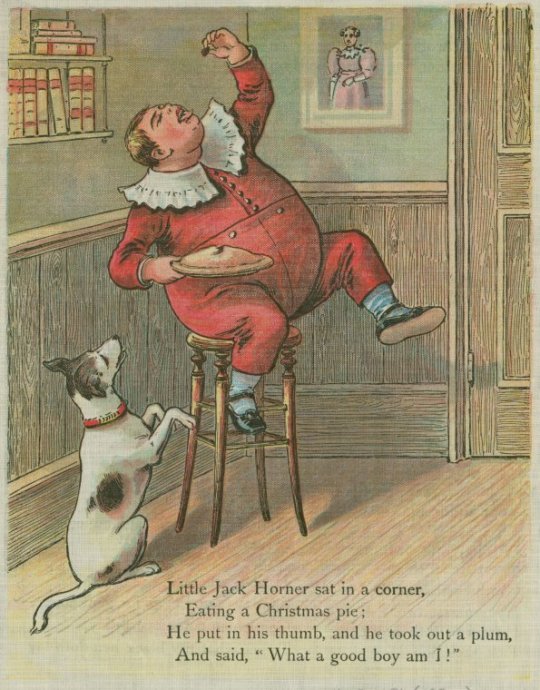
Jack Horner's original text is the least well known property out of the three villain origins. "Little Jack Horner" is an 18th century nursery rhyme that's short enough to be read word for word in the film, and short enough to be included in this essay:
Little Jack Horner
Sat in the corner,
Eating his Christmas pie;
He put in his thumb,
And pulled out a plum,
And said, "What a good boy am I!"
That's the whole thing, some kid eats a plum out of a pie. However, even in its early days the Jack Horner rhyme became (somehow) associated with the themes of greed and opportunism. Let's try to follow the logic: we have some kid, CLEARLY financially privileged enough to receive a pie for Christmas, decides to steal a plum out of the center of the pie, ruining it with his dirty kid fingers before anyone could cut the pie to share, then he has the gall to declare "what a good boy am I"! THIS FUCKER. The pie is the wealth of the common man, or something, and the plum is, like, the fruits of their labor, and this BOURGEOIS child is reveling in his destruction of the economy with his hunger for profit (and plums).
It sounds stupid because it IS stupid, but the association stuck and found use in a surprising amount of historical literature and political writings. I can just rattle off examples from the Wikipedia article: English poet Samuel Bishop uses Jack Horner as a critique of the Civil service bureaucracy, the satirical novel Melincourt (1817) has 5 people sing a song describing how they misuse their trades to fleece the public that compares themselves to Jack Horner, etc, etc, there's like 6 more examples. Also fun is the fact that educators in the 1800's have made attempts to sanitize the Jack Horner rhyme by adding verses that describe Jack Horner totally sharing his pie afterwards because it's the good ethical thing for little boys to do. Jack Horner shows up in war propaganda, it's absolutely wild.
This is the historical context behind the little Jack Horner rhyme, the reason why Jack Horner represents capitalistic greed and cruelty in the movie. I had to look this stuff up after the movie, who even knows about this stuff, but the writers have seriously done their homework to find a nursery rhyme with a historyc this interesting, and it's fascinating to see how they worked to recontextualize this rhyme into a movie villain for Puss in Boots. I say this, because the next layer of Jack Horner's narrative construction is even more interesting.
5. Jack the Anti-Pinocchio
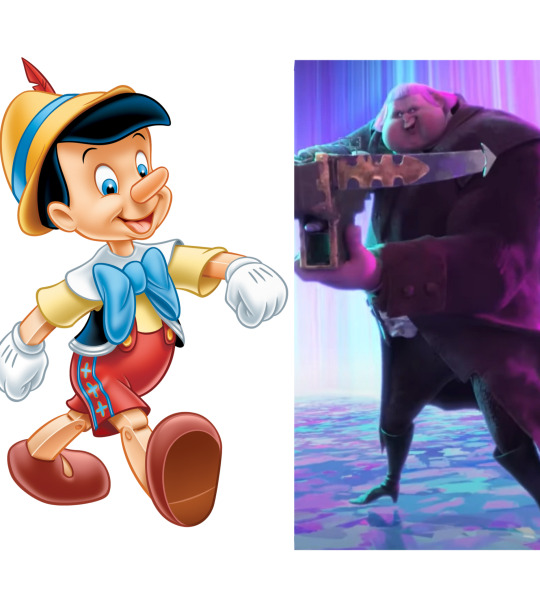
Drew like a dark, fucked up version of Pinocchio, haha. Just a glimpse into my dark reality. A full stare into my twisted perspective would make most go simply insane, lmao.
Jack Horner's screen time is punctuated with references to the story of Pinocchio, who I'm sure we are all familiar with. Jack's intro flashback features Pinocchio and he spends a lot of time with "ethical bug", the very shameless clone of Pinocchio's cricket. On one hand, this is a very clever way to contextualize Jack Horner using a better known media property, but on the other hand, the choice of Pinocchio is very deliberate because Jack Horner is used in this movie specifically as a dark, villainous reflection of Pinocchio. 2022 is truly the year of Pinocchio for bringing us three Pinocchio movies and ending the year on the Anti-Pinnochio: Jack Horner.
Pinocchio is the story of a little puppet boy, naive to the ways of the world, learning how to be a "good boy" through trials and tribulations. He fails to listen to his father and his companion cricket sometimes but he ultimately learns a sense of morality and kindness. Compare and contrast this to the use of "good boy" in the Jack Horner rhyme, where Jack ruins a pie then ironically declares himself a good boy. This is where the parallels start: Jack Horner at multiple points calls himself a "good boy", but he has done nothing good to earn such a title. Everytime he says "good boy" it is not only a reference to his own rhyme, but as an ironic allusion to the story of Pinocchio as well.
Consider the appearance of Pinocchio early on in Jack's introduction scene, where Jack is upstaged by Pinocchio's magic puppet show and becomes jealously possessive of magic. The significance of that scene comes from the fact that Pinocchio's magic body is NOT a net positive advantage for Pinocchio: as a puppet Pinocchio struggles to fit in with human children, but the only advantage to his magic body is his ability to entertain crowds for stage shows, if he offers his only asset up for commercial exploitation. Not only that, but Pinocchio's magic forces his nose to grow when he lies, so it's as much a liability as it is an asset. Jack is jealous of a socially underprivileged child for the ONLY advantage Pinocchio has, planting the seeds of Jack's characterization mere moments after his introduction.
Jack's journey with off brand cricket completes his characterization. We see him abuse his men against the advice of cricket, but we also see that he perfectly understands cricket's advice, he just has no interest in being good. Contrast this with Pinocchio, who also fails to heed cricket's advice, but only because he is naive and fails to understand the nuances of the advice. We also learn how he was overwhelmingly privileged in life but still wishes for magic, the only privilege he's ever been denied, and his intention to hoard it from everyone else. Jack is written with the intention of filling the role of the monstrous, unsympathetic villain, and so it was a very deliberate and intelligent decision to frame him as the moral antithesis of a "good boy", the moral antithesis of Pinocchio. What morality Pinocchio has to learn, Jack disregards completely and declares himself a "good boy" anyways. Each of the three villains in this movie is designed around their respective archetypes, but Jack Horner takes his design prompt and fucking SOARS.
6. The Shrek Cinematic Universe
Let's take a brief detour through the history of the Shrek franchise.
In 1994, Jeffrey Katsenberg was ousted from a chairman role from Walt Disney and went on to co found DreamWorks Studios. The original Shrek movie started development the year after in 1995, as a very loose adaptation of a now very obscure children's picture book of the same name. It is often said that Shrek was written as a cynical parody of the fairy tale films of Disney as a form of revenge from Katsenberg. Disney films at the time were known for being family friendly and moralistically pure and full of beautiful, wholesome heroes on noble quests, and Shrek sought to subvert those expectations deliberately. At release Shrek had become an amalgamation of various fairy tale stories, featuring many parodies of Disney properties such as Pinocchio and Snow White. The humor was crass and irreverent to contrast with the properties of Disney, with a story focused on the uglier, dirtier ogre Shrek learning to become an unconventional hero to a fairytale kingdom.
It turns out the market was indeed craving the kind of off beat fairy tale that Shrek had become, as an alternative to Disney's clean, beautiful properties. Shrek's celebration of unconventional beauty and its clever parodies of classic fairy tales both struck a chord with audiences, and the Shrek franchise has been a DreamWorks classic ever since. The two Puss in boots movies are spin-offs of the Shrek franchise. Both Puss in Boots movies differ from Shrek in the way that they use fairy tales: the fairy tales are still different from their original contexts, but they are much closer to their original meanings rather than fully comedic comedies. The first Puss in Boots was a moderate success while the second Puss in Boots is critically acclaimed and seems to be on track to revive the entire Shrek franchise.
I want to highlight the strategy Puss in Boots: The Last Wish has found for handling its fairy tale properties, and how it contributed to this film's current success. Puss in Boots has figured out the storytelling potential of becoming a sort of cross over film for multiple fairy tale stories, recontextualized for a modern audience, but with more faithfulness and sincerity to the original text than the Shrek franchise before it. It's reminiscent of the very popular Marvel Cinematic Universe, but for even older public domain stories. In a way this is still within the spirit of Shrek, it still makes use of an ensemble cast of reimagined public domain fairy tale stories to construct a new, modern narrative. It even has some parallels to the original Disney properties that led to the creation of Shrek, as Disney also built its brand off the adaptation of the same public domain fairy tales that make guest appearances in Shrek.
This style of storytelling has the unique power of reviving older, forgotten media properties into fresh new narratives, made even more complex by blending multiple stories into a single movie and forcing them to develop new meaning through interacting with one another. This approach does an incredible job of capturing the essence of Shrek: Shrek himself is a lesser known property elevated to the status of a cultural icon through his interactions with an exciting ensemble cast of comedic fairy tale imaginings, and the Shrek franchise is responsible for bringing attention and meaning to even more fairy tales and nursery rhymes, some well known, some not. Might I remind you, Puss in Boots himself was not amongst the most popular fairy tales such as Pinocchio and Cinderella, the properties that were themselves brought to fame by being associated with the Disney brand. Shrek is often praised for its celebration of unconventional beauty, and while this is true for its celebration of literal unconventional beauty features, it's also a celebration of the revival of the unconventional, forgotten stories of the past that have the potential for new life.
I say to you that Jack Horner is the perfect encapsulation of this, the spirit of the Shrek franchise. This excruciatingly simple 6 line nursery rhyme, kept alive throughout centuries through artists extracting a comical amount of political meaning from it, now revived once more by the talented team at DreamWorks. Jack Horner had the least well known origins of the three villains, many people didn't even know the nursery rhyme going into the theater, but the amount of care put into his narrative construction is a monumental testament to the power of narrative reinvention. All this, at a time when the Shrek franchise itself was in decline and required its own reinvention to survive. This, when Puss in Boots 2 required bold new changes after the lukewarm reception to the first Puss in Boots. A daunting task, but if a property as obscure as Jack Horner can be revitalized with such vigor, then so can the Shrek franchise.
I'm tearing up about Jack Horner why the fuck is this happening.
65 notes
·
View notes
Text
Gdcn't #1 — Understanding Others
This week, from the 18th to the 22nd of March, it’s the Game Developer’s Conference. This is an event in which Game Developers from across the industry give talks and presentations on what they do and how they do it to their peer group. In honour of this, I’m presenting articles this week that seek to summarise and explain some academic concepts from my own readings to a general audience. In deference to my supervisor, I am also trying to avoid writing with italics in these articles outside of titles and cites.
There’s an association with academic reading that fundamentally, academic writing and thinking is about a disconnected experience of reality that is explicitly not practical or realistic. ‘An Academic Point’ is a term we use to describe a thing that isn’t connected to any kind of realistic experience. I want however to talk to you about an idea from academia that gave me words to describe something I found important for living my life and being a better person. It’s an idea, it’s a tool, it’s a pitfall, and it is, importantly, a story.
It is a story that starts with the technique I use in my research called ‘autoethnography.’
What I do, generally speaking, is work with the academic toolset of autoethnography.
Autoethnography is a process of engaging with an experience, recording that experience somehow, then academically and critically engaging with the recording of that experience. I like to point to a number of forms this takes in general media – movie and game reviews, for example, are autoethnographic texts, where the experience of the reviewer is shared to an audience in a way that seeks to make that opinion a thing people can meaningfully engage with. Autoethnography is powerful for giving writers a way to share individual experiences that are not necessarily in forms that research can conventionally access. Quantitative research is very good at reducing averages and statistical trends out of large sets of data, with larger and larger sets of data being able to have more and more confidence – but how does that toolset handle addressing information that has happened to small numbers of people, and with access to an even smaller number of those people?
I like autoethnography and I like a lot of the researchers who use autoethnography. This is partly because they bring the tool to bear on ideas like the experience of being a closeted queer person or the emotional challenges of being an adopted parent. Partly it’s because it is a form of research that strives to respect the writer as part of the writing, and therefore what they experience and who they are is worth sharing and explaining. You know a little bit about me, hypothetically,
Autoethnography is — well, autoethnography is new. It’s also very old. The term autoethnography has been considered an academically useful term with a specific meaning since 2004, but prior to that its use is ambiguated by the people who were using it. Autoethnography isn’t a recent field, really, nor is it a recent word. If you want to point to the time in history where it first gets coined in the terms of the specific process of academic writing I’m doing, you look at the work of Carolyn Ellis, along with her cohort of fellow storytellers and meaningmakers, in the book Autoethnography: Understanding Qualitative Research, 2015. By this timeline, Autoethnography is an academic discipline younger than Shrek 2.
If you want to step back through the timeline there are earlier works from other cultural writers talking about the idea of autoethnography, but not in those words. Ethnography, the study of culture, is something we’ve been doing for a long time, and by ‘a long time’ I mean ‘pith helmet and shooting people’ times. Autoethnography is an attempt to do this kind of cultural analysis that’s aware of the non-objective nature of the ethnographer. This idea that ethnography is not object is the result of numerous critics of the form, but one critic I want to highlight is a man who is responsible for coining the phrase key to this whole story.
Let’s call him Dwight, for now, because, y’know, that’s his name.
Dwight is responsible for writing the essay I Am A Shaman: A Hmong Life Story With Ethnographic Commentary (1986). I’ve not the text on hand, but that’s not too important here. The important thing is that with the title ‘I Am A Shaman’ the writer positions himself in the middle of the story of Hmong shamanism, set in the context of Hmong refuees in the Ban Vinai Refugee Camp in northern Thailand. Dwight came from Thunder Bay, in Canada, and spent years in this research becoming part of the community, approaching it authentically, and bringing what he could understand from the community in his research. This set something of a trend for this guy – he also worked researching the Chicago tenements, known as ‘Little Beirut,’ and then worked on American attitudes towards the death penalty. Generally speaking, I understand Dwight’s work to be well-regarded, respectful, but also, importantly, deeply involved in the communities he was researching.
In his work, Dwight describes four attitudes towards the other that are problems when writing about culture. He describes them as:
The Custodian’s Ripoff. This is when a researcher appropriates cultural traditions in order to enhance their own projects. Imagine a museum curator who wants something interesting to build their repertoire of artifacts.
The Enthusiast’s Infatuation. This is when a researcher is really into a superficial impression of the culture, which means they tend to ignore the differences between themselves and the other, and speak for them in ways that don’t appreciate the depth of meaning there. It’s fanboying for the culture you’re researching, as it were.
The Curator’s Exhibitionism. This is when a researcher is trying to sensationalise and astonish with what they report, wanting to show the exotic, the primitive, and the culturally remote.
The Skeptic’s Cop-Out. This is when the researcher just gives up and becomes detached from the research, suggesting it’s impossible to learn about, nor perform, as persons who are different from us.
It’s this last one that stands out to me. The Skeptic’s Cop-Out. The idea that while trying to learn about something, you find it too hard to find your own emotional connection with it, you find it too difficult to imagine being another person or a person of another perspective, and just give up and assert nihilistically that these things are impossible. This is a perspective you might see a lot in your everyday, with ‘I just don’t get it’ responses to queer ideas from non-queer spaces. There’s a cousin to it, too, in those queer spaces – you know, ‘cis people can never understand.’
Don’t take this the wrong way, by the way: People saying stuff like ‘cis people can never understand’ are probably basing that on some pretty meaningful personal experiences about not being understood by cis people. That doesn’t mean they’re right though.
I write about trans and gender issues pretty regularly. This isn’t because I am trans and have gender issues — it’s partly because I find them interesting, and I find the way they get talked about rarely intersect with the things about them that I engage with. For me, how to represent a trans character in a game matters a lot – no trans people are going to ask me how to expresss their being themselves in their lives, and nor should they. This got to a point where, a few years ago, someone asked me why I bothered to talk about it so much, because why would I if I wasn’t part of the community? Was it my place?
This is one of the first times I apparently made it clear that I’m bisexual in any space online, because I felt like I was being asked to show my queer papers. It was an unpleasant experience, but it came with it an unstated and slightly sad assumption I could see in the shape of the question:
Why would you try and understand or relate to trans people this thoroughly, if you weren’t one of them?
And that’s messed up, right? That’s a deeply sad assumption to have to deal with in your everyday life? Trans people aren’t the Black Speech or the Pattern Screamers, they’re not something where understanding them poisons your mind. They’re people. They have their own jokes about hoodies and salt licks and bananas just in the same way that tiktokkers have their own jokes about air friers and gotta-hand-it-toing Osama Bin Laden. They are people who have a cultural experience and that cultural experience has both shared signifiers (being trans) and they have unrelated experiences (most of everything in their lives that isn’t part of being trans).
I think as long as people are sharing information about who they are, that is information you can engage with. You can listen and you can ask and you can, if you are willing to, come to recognise why things are the way they are, because none of this is being built out of a magical, or spiritual perspective on reality. You don’t have to feel a thing to understand when someone else tells you how they feel. All it takes is being willing to listen to the people, remember what you’re told, and treat the telling with respect.
Here’s the big thing that sticks in my brain, that makes this list so easy to bring to mind, because it’s such a weird detail. Dwight, the guy who had these really serious thoughts about access to critical and ethical spaces, this guy who wanted us to think about who we were and how we can, if we are willing to try understand one another on a deeper level than these, had the name Dwight Conquergood.
Check it out on PRESS.exe to see it with images and links!
6 notes
·
View notes
Text

Analysis : The role of freedom
Role in Neon Genesis Evangelion: Existence of Kaworu Much better explained by fiendswithbenefits@tumblr
Kaworu is that one character that pops out of thin air and appears for Shinji. A lot of people can't grasp Kaworu's full character because of this, but just like EVERY SINGLE EVA CHARACTER, he is covered in layers like onions shrek reference and has a very defined personality, story, background and role. Kaworu's out-of-character role is the unrealistic existence of unconditional love.
He exists to be seen as Shinji as pure love, love he never had, unconditional and untouchable, but he also exists to show Shinji that sort of love can't exist. It's not real. No love will ever be like this, even if that's what Shinji idealizes and dreams of. In fact, he created an image of Kaworu and he betrayed himself when he realized Kaworu wasn't what he dreamed of. "You betrayed me, you hurt my feelings" as he screamed at Kaworu was proof that Shinji saw kaworu as perfection and when he realized Kaworu wasn't perfect, he got mad. Kaworu also represents choice. It's hard to see this, a lot of people say he represents selfishness, but being selfish is also a choice. He can be both, honestly. Passing Shinji the responsibility of killing him and choosing to die, this is both a choice and selfishness. I don't feel right calling Kaworu suicidal, but he did want to die. It was his choice to; he could have killed himself before he met Shinji, but he chose not to. It's about choice and consequence.
He also represents validation. Shinji needs to learn to validate himself in order to love and to be loved. "You can't be kind to others, if you aren't kind to yourself" is what Misato told shinji during episode 26. Long story short, Kaworu biggest role is to tell you: Don't sit and wait for unconditional love to fall on your lap, it's not real. And to expect it to be real will only hurt you. Realize that nothing is perfect, but you can still see good in it. It can still make you happy, even if it's a short time. And so what it's not forever? Didn't it make you happy then? Doesn't that make it worth it, didn't it teach you something worthwhile, like what it feels to be loved?
Role in Neon Genesis Evangelion: Death of Kaworu Much better explained by fiendswithbenefits@tumblr
Kaworu has many reasons to die depending on the canon timeline you take him from. I'll focus on the anime series since I play Kaworu from the anime version. Overall, it follows the same pattern, except for the manga where he dies for something different and I don't think it's necessary to mention this.
First of all, Kaworu is an angel. Not any angel, but he carries the soul of ADAM, the first of all Angels and Mother of all Angels, and like every angel, he wishes to return to Adam. He can't fight it, he can't help but to feel it. And eventually he would go to Adam, so he claims. In truth, Anno told us that NO, Kaworu could very well restrain himself and just live as human. The thing is, because of the way Kaworu is and grew, he was never given that possibility; he was never told he could have the human choice. If shinji had told him "it's ok you are an angel, we can still be together", Kaworu would have survived.
You will realize that Shinji will come out of this as a very terrible person. He is. I love shinji, and he has much of my sympathy, but he makes terrible choices or avoids making good choices. Shinji is SO selfish that he could only think of himself during the Terminal Dogma scene. His hurt feelings, his traumatic experiences, his pain, how HE has to kill Kaworu, how it's HIS burden. He didn't think of ever looking at Kaworu and ask him to live; instead, he said he didn't understand and that was enough of a reason for him not to TRY to understand. He refused to, said no, or "i don't understand", which he uses a lot in order to deflect. But he never even thought "Kaworu you can live, you have to live, it's okay if you live"
As an angel, enemy of mankind, Kaworu had to be erased. it was either that, kill lilin, or carry out SEELE's version of instrumentality, these were the only options Kaworu saw. So he decided to die. Misato says "he wanted to die" because this is true, Kaworu did. It was his choice to, and he honestly didn't see himself to have many other choices. He was trapped in what he was and what he was meant to be, and didn't realize he - just like humans around him - could be more. It didn't cross his mind because that would be very human, and Kaworu is not a human and he is very aware of his nature.
It's also necessary to remember Kaworu isn't just about shinji. He lived before he met shinji. Can you imagine what sort of life he had? No? Let me then tell you that in the first drafts Kaworu was meant to be clueless about his nature and when he found out at the age of 10 he tried to kill himself. This is the first draft, and while it was discarded, the meaning behind it was not.
Kaworu has issues too. Probably more than Shinji and as many as Rei. He is a CLONE, with a soul of a God-like-being, his body isn't his own and he carries the body of a human which goes against his angel nature. He lived a conflicting life, not just regarding his mental stability, but even his biology and physiology (remember that Rei must eat a lot of pills to keep her body? Yeah, Kaworu too, technically). We don't truly see these issues because Shinji doesn't see them. Kaworu not only keeps them to himself (he shows us a saddnes and conflicted expression when he reached the Terminal Dogma), but we also don't see it because Shinji simply doesn't want to see his idealized lover as what he truly is. Shinji saw exactly what he wanted to see: the perfect love interest to swoop him and validate him. Shinji neglected the child, just as broken and wounded as he was, if not more.
Does Shinji love kaworu? He does. He truly does. But he loves the idealized part of Kaworu and refused to accept kaworu had his own issues. Because it's all about shinji. Kaworu passes his death onto shinji's hands not only as a choice, but also to show him more of Kaworu's imperfections. Kaworu wants to die, so you must be the one to kill him, Shinji. And shinji is too late, as well.


Lilith-Adam/Rei-Kaworu Taken from fiendswithbenefits@tumblr
Let’s review what we know:
Lilith-Adam is capable of sending messengers either forward or backward in time, presumably because as an actualised deity, time is essentially meaningless.
Asuka, Misato, and Ritsuko - despite dying beforehand officially - all factor into Instrumentality. Based upon episode 26, Kaji also factors into Instrumentality (one could argue that it’s “all in Shinji’s head”, but it makes more sense if Kaji’s actually in Instrumentality).
Lilith-Adam is capable of turning every single soul that ever existed on the planet into a form without A.T.Field (tang yeah).
For people in the past, Lilith-Adam consistently tangs them at the moment of death. Conversely, for people in the present, Lilith-Adam tangs them at the moment of Instrumentality (which in turn becomes death).
The Earth would not be able to support of every human being in existence. Not to mention every other living creature.
End of Evangelion's closing lines strongly, strongly, strongly suggest that humanity will be able to recover and continue to live; as long as the Sun, the Moon, and the Earth exist, everything will be all right.
So the way that I see it personally, there are two explanations (if you can think of something else, please let me know).
Lilith-Adam has tanged every human being in existence all of the way to the past, which means that the history/past of humanity is now one massive tang. Now, because the quantum Rei appear to exist within either some form of stable time loop, or they function via the parallel-universe theory of time travel, everyone would still retain their memories at moment of death. In this case, my immediate assumption is that most people would refuse to come back from Instrumentality … or, alternatively, that Instrumentality actually functions as a “sort of heaven”: When people of the past die, they’re tanged. Now it becomes an even stronger metaphor for Shinji rejecting both death and an escapist fantasy for the real world. Now that’s impressive.
Rei’s still subjectively human. She isn’t going to tang everyone, but she is going to also go back and tang her close friends. In this case it’d be “everyone currently alive on the Earth, plus a few people about whom Rei cares deeply”.
I do have one more theory: It doesn’t matter. The “science” of Evangelion has never been “the point”. “The point” is that Asuka and Shinji act as audience avatars and as metaphors for the typical destructive humans that interact with one another solely to cause each other pain and grief. In the ending of End of Evangelion, Shinji starts to choke her out of fear that they’re still in Instrumentality. Asuka and Shinji could fight and potentially murder one another on the beach. But instead Asuka’s gentle. Instead, Shinji ceases the violence and chooses to cry, having realised that his first action to another human being was one of violence.
They’ll get better. We all will.
So the actual reason or process behind something like this doesn’t truly matter either way. Evangelion is, at heart, a work based upon emotion, psychology, and love. As such its level of science fiction hardness … is probably so soft you could spread it on bread. And that works in its favour by forcing the focus on the emotional and psychological: Evangelion excels at character development and dealing with depression/emptiness/etc. in all of its forms.
Regarding Kaworu and Rei, at the End of Evangelion, would they be able to return to their forms, like it happened with Shinji and Asuka, and could happen with everyone who got tanged? In all honesty? NO.
Kaworu/Adam, the mother of the angels, and Rei/Lilith, the mother of the lilim, both necessarily represent mother figures in the course of Evangelion. And we can even broaden that out to be parental figures, figures which die and which must be given up.

It’s why Gendo gets tossed into the metaphorical dumpster. He refused to let go of Yui, that perfect love interest, always framed in a delicate light (haha not really, but you can read my Yui analysis for that), and clearly representative of the mother. Gendo was willing to throw his own child under the bus, was willing to throw all of humanity and the angels under the bus, was willing to throw his life and happiness under the bus, all for Yui’s sake. Which isn’t how to live life. Don’t waste it on searching for what you perceive to be perfect paradise, because it doesn’t exist.
It’s the same thing with Rei and with Kaworu. Rei is linked to Yui by image and by mother-like significant to Shinji; she dies because of the mother thing. After all, Rei, too, is akin to that perfect person by the end of the story, likewise offering all of humanity her unconditional love, and keeping all of humanity in her womb (the Black Moon; when the Black Moon is destroyed, it bleeds over Rei in a manner very reminiscent of a bloody birth). The perfect fantasy of Rei and Instrumentality must fall for humanity to be born in the true reality.

Bringing them back would break the thesis of rejecting the escapist paradise/death in favour of reality. Y’know? Besides, on a practical level, Rei and Kaworu’s bodies weren’t “tanged” (turned into the orange LCL-ish stuff), so the chemical makeup of their bodies doesn’t exist within the LCL. And beyond that, Rei and Kaworu also sacrificed themselves to ensure that a war between the lilim and the angels would never again occur. If they were to return, they’d run the risk of Impacts and all of that nonsense happening all over again.
5 notes
·
View notes
Text
Not me being ready to throw hands with Nicholas over his claim of Shrek 2 being the great animated film of all time.
Listen here, Mr. Galitzine, that movie is funny, I'll give you that, but the rest of it is a flaming dumpster fire. It also has to rely on fart/burp/snot/poop jokes and "adult jokes" so much that the actually clever jokes are lost. Also, it's a movie, you know, like, it's supposed to have a good story? And be well executed? If you want to laugh at gross and dark humor, go watch a comedy show!
Also, it's the exact same primary conflict of the first film, as is every Shrek film. Every single one is "Shrek's an ogre; he's grumpy and gross and doesn't like people" just in a new situation.
Movie 1: Ogre is grumpy/gross/ugly/doesn't like people and doesn't mix with princess. Movie 2: Ogre and princess don't mix, this time with parental baggage. Movie 3: Ogre can't be a father cause he's grumpy/gross/ugly/doesn't like people. Movie 4: Ogre wants to go back to being "ogre" all the time, aka grumpy/gross/ugly/doesn't like people.
And every time the ending is like "Oh he's actually got a heart" but goes right back to being an asshole in the next film so they can do it all over again!!
You wanna talk about being passionate about this, you haven't seen passionate, sir.
You're speaking to an autistic person who has been hyper-fixated on the original How To Train Your Dragon since it came out in 2010. I did a film scene analysis for a college class on the sequence that is referred to as "Forbidden Friendship" as that is the title of the track from the film score that plays during that scene. I could, and probably will, do an entire video essay on this film, because that is one of, if not the best animated films of all time, based on quality of storytelling, methods and execution, musical composition, shot composition, character work, etc. etc. etc.
You're speaking to an animation major who has a personal vendetta against the film industry for treating animation as a lesser form of medium because of movies like Shrek. I could debate you under the table on this subject.
You wanna say it's your favorite, and that you like it the most? Perfectly valid statement based entirely on your own personal enjoyment of the film. To claim it's the "greatest animated film of all time" is relating to the quality of the film.
Those are two entirely different things, and too many people consider them to have the same meaning. You can dislike something, and recognize its high quality, just as you can like something, and acknowledge its low quality.
I simply will not tolerate this slander.
Okay, I'm done, sorry lmfao I'm not genuinely attacking him for this btw, this is very light-hearted. Is it completely true? Yes, but I'm not actually upset with him or anything. Please don't react like I'm trying to cancel him lmfao
#fight me#but not seriously#ily nicholas#i just vehemently disagree with you#and greatly desire to have a conversation about this topic#i need to know if you understand the difference#cause way too many people don't#and it makes me want to scream and sob at the same time lmfao#nicholas galitzine#animation#shrek 2#how to train your dragon
5 notes
·
View notes
Text
bad buddy fandom getting-to-know-you meme!
note: i consider "fanworks" to pretty much everything people create related to a fandom, including but not limited to meta/analysis/discussion, gifs, fanvids/edits/fancams, filk, fanart, fanfic, fan food, fan crafts, etc. please include this note with the meme unless you have a different definition!
name and whatever you want to share about yourself
hi i’m yarrow, she/her, i’m 28, i’m bisexual, i’m having the time of my life. i live in NY. if you’re a mutual who also lives in NY by any chance we should be friends
when did you watch bad buddy/join the fandom?
watching bad buddy was the first thing i did this year and it didn’t take me long after to make this blog. it hit me so unbelievably hard, i was reeling, i’m still reeling. i know i’m preaching to the choir but for me it’s unlike anything i’ve loved before. i had been out of fandom for like. almost ten years. before bbs (and a small handful of other beloved thai bls) yanked me back in
favorite ship(s)
well you know. the obvious one. inkpa too OF COURSE. waikorn cracks me up even if i’m a nonbeliever. i loved whatever was happening between pat, pran, phupha, and tian. and i also love, in a platonic way, pran’s dynamic with ink (he makes fun of her bracelet/fakes her out by saying he also liked her…as a friend. it’s very endearing very sibling-in-law) and pran’s dynamic with pa (in bbs but also in bbsos2)
favorite character(s)
god how to choose between pat and pran. they are both characters of all time. well-developed with idiosyncrasies and penchants for lying and performing and slipping into roles and reversing roles. especially when they’re with each other of course. i might choose pran simply because i see more of myself in pat if that makes sense
favorite episode(s)
it’s probably episode 5, or episode 11. both these episodes just take everything out of me. you know why. runners up: episode 3 and episode 12. this is hard to pick because there is not a single episode i wouldn't enjoy (lol) randomly rewatching. all bangers no skips
favorite scene(s)
i love the scene in episode 4 of pat telling pran his dimples are cute. episode 5 fight scene my beloved. then there's the entirety of the bet era like aside from how perfect it is for pat and pran…it’s just peak romance, peak build-up, such a pleasure to watch. i reeeeeally do love the fantasy sequence of pat and pran eating dinner with pran’s parents in episode 11, i’m fascinated by it in a meta sense but also it hurts so good. i like ming and dissaya hearing pat and pran laughing and singing together in pran’s room in ep12 and being utterly powerless to stop it. it’s like, the show didn’t necessarily need all of ep 12, but it was such a welcome and fitting epilogue to these beloved characters and their love. pat and pran are gonna be alright...
one thing you would change about the show if you could
i really appreciate all of its imperfections honestly but. it would have to be the aftermath of wai outing pat and pran. even in my first watch it was a head scratcher that pran was expected to be the one apologizing. it just didn’t add up. there was a weight behind what was happening that the show didn’t realize. i can rationalize it and explain it away to make wai somewhat less heinous in universe but it really should have been treated as what it was: an outing. also yes let ink and pa kiss.
what are your some of your favorite fanworks made by other people?
you know i’m a sucker for @kit-teung's art
and for @hereforlou's art. pure domestic bliss that pat and pran have EARNED. this is the fanart reimaginings they deserve. also i love their little cowlicks
@miscellar's meta series the comprehensive shrek breakdown of pat and pran's story in our skyy (particularly for ep3 which i linked). i was in the trenches those two weeks in late may/early june and these posts (and their dms) were my guiding light...all of miscellar's meta is extremely baller and forever on the bbs 101 syllabus in my mind. and for some reason i’m waiting to read more bad buddy fanfiction until after i finish my own BBS fic but I’m excited to read their zombie patpran. so it gets an honorable mention here + they get so many anons singing its praise like i literally can't wait
also I’m not on Twitter much at all but the other day I read @dimplesandfierceeyes's pinned thread and listen it got me through the day. just read it if you haven't.
@transpat's "pre-relationship patpran and haq" post about the unspoken entitlement they entrust each other with. a deep dive into their pre-relationship dynamic. it's so good. an all-time bbs meta
@ranchthoughts (and me a little) talking about Pran's "Pat you've got to stop doing this to me" line in ep 5 here. i fucking LOVE this line and this meta. ranch's baseball mom shirt meta also required reading
"Bad Buddy, Tragedy, and Queer Futures" essay by @chickenstrangers, another all-time bbs meta, required reading. i go back to this one a lot
(if you create fanworks) what are your favorite fanworks that you’ve made?
my favorite bbs fanwork I’ve made is the unreleased patpran timeloop WIP that has been burning a hole in my gdocs for the past month. i’m having so much fun writing it but wow it’s also driving me up the fucking wall (affectionate)
i also really enjoyed all the meltdowns in the tags/notes when i posted this about that ep11 scene i love. and then this is my love letter to bbs, i think it still holds up idk my bbs os2-induced manic episode is all a blur.
idk anything else you want us to know?
thanks @fiercynn this was so cute
i’m tagging some mutuals who post about bbs fairly often who i havent seen do this yet (i think?? i’ve been kind of absent lately). if i didn’t tag you and you want to do it please do, you can say i tagged you <3
@chickenstrangers @miscellar @hereforlou @ranchthoughts @midnightfreeway @philologique @neonsbian
#i'll tag this as#about me#i have no tag organization system idk#it took me so long to find some of the posts i linked#i hope everything is linked right my brain actively fights against me with these things
15 notes
·
View notes
Text
Fanfiction Throwdown!
Fictional Throwdown Friday applied to fanfiction characters. These fan works can be anything from fanfictions, fan songs, fan games, mods, scripts, creepypastas, and more. The original creator reserves every right to ask my to take these down and I will seek permission in advanced when possible.
This Week's Fighters...
Cursed Woody vs Corrupted Woody!
Sources:
Cursed Woody from Cursed Woody sings a song.
Corrupted Woody from Slender Fortress
Conditions:
No restrictions.
Scenario:
After inacting his vengeance on Andy and his friends within his timeline, Cursed Woody aims to start killing alternate versions of his friends across multiple timelines. As such, he approaches Slenderman and asks him for sych an opportunity. Slenderman already has an evil version of Woody under his command and makes Cursed Woody fight Corrupted Woody to the death to see if he's worth the bother.
Analysis: Cursed Woody
youtube
That's it. That's everything you need to know about Cursed Woody right there. It's literally just that song.
Analysis: Corr-
Alright fine, I'll go into detail.
In this edgy alternate universe of the original Toy Story, Woody does not escape Sid with Buzz. He's abandoned to serve as Sid's tortured plaything, pulled apart and stitched back together for days until something just... snapped.
Presumably murdering Sid in his escape, Woody sets out to avenge himself on his old friends for abandoning him. And he has all the murderous cunning he needs to do exactly that.
As an alternate version of canon Woody, Cursed Woody should have all of his same powers. Namely, the ability to survive being ripped apart and dismembered with no ill effects. Due to being a toy with no organs to crush or blood to spill, Woody can survive things that would certainly kill an ordinary human, such as having his head crushed or his arm torn off. In the backstory here, Cursed Woody survived days of being ripped apart and stitched back together like a "cowboy Frankenstein" with no physical ill effects. Psychologically however, he still very much feels pain.
Woody is a clever, well armed serial killer more than capable of slaughtering all his old friends. His weapons seem to be capable of nullifying the survivability inherent to other toys, seeing how what he does to them here would not be enough to kill them normally, and Woody here is strong enough to even overpower ordinary humans despite being just a toy.
Woody carries a wide variety of weapons, ranging from guns, knives, and hammers. He's strong enough to smash ham to pieces, fast enough to catch up to RC Cars, which can move at top speeds of 44 meters per second, and smart enough to track down and slaughter Andy and his family as they try to hide.
Cursed Woody is a far cry from the friend in me we've all come to love. He's murderous, vengeful, sadistic... and very, very memey.
Just... a massive meme.
Analysis: Corrupted Woody
Slender Fortress is a mod for Team Fortress 2 that puts the Mercs of the RED Team against the notorious Slenderman himself without any of their weapons as the BLU Team spectates. What started off as a basic Slender: The Eight Pages recoloring soon grew into an impressively sizable community, creating their own maps and monsters for the RED Team to be terrorized by. No matter where the Mercs went, they'd always be hunted down by Slenderman and his proxies. Some of them are OCs, some come from other franchises, and some are horror legends. Killers from Outlast, Killing Floor, and Dead by Daylight all unite under Slenderman's banner to destroy the Mercs wherever they go. And none of them are more dangerous or more popular... than Woody from Toy Story.
Alright, some context. Some of the "proxies" that chase you in Slenderman's steed are clearly just meant to be jokes with no actual context in the paper thin plot. Shrek, Senator Armstrong, Kazuma Kiryu, etc. Woody started out no different... until he got popular. And people actually started to try making him scary.
In order to Corrupt Woody to his cause of muder and mayhem, Slenderman exposed him and his friends to a mysterious, dark corrupting slime. This ooze grew them up to human size, gifted them with superhuman strength, and made them completely subservient to Slenderman's will. Now a Corrupted Woody, Buzz, and Jessie hunt down his victims with murderous intent, nothing but empty shells of their former selves.
All of Slenderman's proxies have a passive effect known as "static", wherein looking at them or remaining too close for too long can allow them to completely overtake your mind, killing you instantly. This strength of this varies from proxy to proxy, with Woody specifically needing up to a minute of eye contact for a fatal effect. As with other proxies, Woody can teleport to search for his victims and duplicate himself to cover more ground.
Corrupted Woody is skilled enough to drag his victims in kicking and screaming with his rope, fast enough to completely outrun Scout at full sprint, and strong enough to make the Mercs explode into giblets in one hit.
Now, I'm very hesitant here to scale this to the actual TF2 crew. Unlike Cursed Woody, which is a full on alternate timeline of the original Toy Story, Slender Fortress is more of a Smash Bros or Dead By Daylight situation. It's a massive crossover setting with no acknowledgement for how the characters would canonically stack up to each other, where Shrek, Chris Walker, and Senator Armstrong all pose roughly the same threat to the Mercs. That and actually scaling Corrupted Woody to Metal Gear Rising would make this entire debate completely null and void. So, I'll have to address Corrupted Woody on his own feats performed here and treat Slender Fortress as its own little universe, for fairness sake if nothing else.
As such, making a human being violently explode on contact would require a generation of energy roughly equivalent to 467 kilojoules.
Source:
In fact, Corrupted Woody is so powerful that the Mercs are completely helpless against him if they get caught. The Mercs are hardy enough to survive getting shot by the Foundation's MTF teams and they can't even so much as scratch Woody.
Original, Woody being the hardesy proxy yo escape in Slender Fortress was seen as a part of the big, ironic joke. Nowadays, it doesn't seem quite so funny.
Throwdown Theme:
youtube
Throwdown Breakdown:
I'll be honest, I did this matchup to jump on the Cursed Woody meme bandwagon before it dies in a week.
Suprisingly, there are a few things to actually go over here.
Cursed Woody does have the win condition of just... shooting Corrupted Woody. Corrupted isn't likely superhuman enough to be bullet proof and I'm not confident in his toy physiology protecting him from this. Slenderman's ooze has altered Woody's physiology so radically that I can't assume he has the same survivability as his canon counterpart anymore. You can also argue Cursed is faster and smarter due to (debatable) RC scaling and not being a mindless slave to Slenderman, but that's where his boons end.
For starters, Cursed has no answers to or ability to prep for static, duplication, and teleportation. If he shoots one Corrupted dead, he's still gonna need to deal with other, which could easily get him ambushed after he thinks the fight is over. Lining up a shot proves risky due to static's effects and teleportation gives Corrupted an option to dodge and make up the potential speed gap.
But, the final nail in the coffin here is that SF Mercs have survived getting shot before. Not tanked, survived. They're not bullet proof, but it is an endurance feat. As such, Corrupted Woody should be able to do the same, as he's physically superior to the Mercs in every way if no vital areas are hit. Doubly so since Cursed's gun is small enough to fit in his hand and therefore would shoot a much smaller bullet with less chance of hitting anything vital.
Also, Corrupted Woody doesn't use AI Art so he wins by default.
This Throwdown's Winner is...

Corrupted Woody!
#fictional throwdown fridays#fanfiction throwdown#cursed woody sings a song#slender fortress#cursed woody#corrupted woody
4 notes
·
View notes
Text
The Beauty of Puss in Boots: The Last Wish
Recently, I just heard about this newly released sequel movie of Puss in Boots. To be really honest, Puss in Boots is one of my favorite characters in Shrek Universe, like it's my childhood (especially I'm kind of a cat person myself lol). He's just too cute and DreamWorks really made a good job making him look even more cute ESPECIALLY like how they portrayed the natural cat reactions between Puss and Kitty- the cat's angry cries, hisses, the purring, the way how a panicked cat falls down (cue on Kitty's reaction when she suddenly got slammed by a growing giant blue posy and I don't really know why the scene was so funny lol) like, it's so amazing???? They really animated how a natural cat acts and it's so accurate!
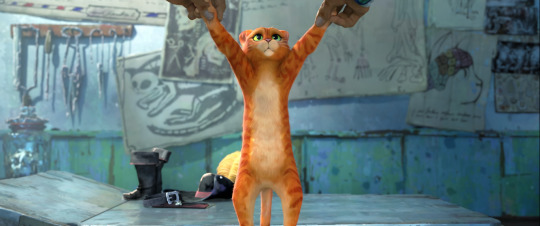

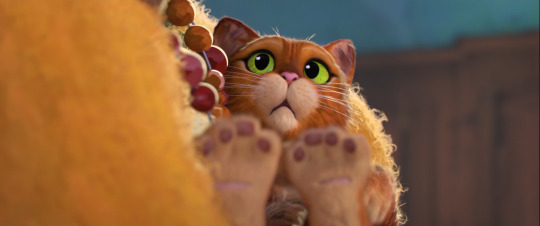
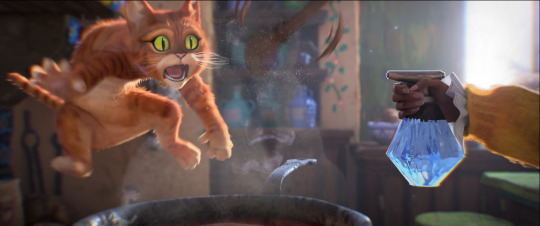
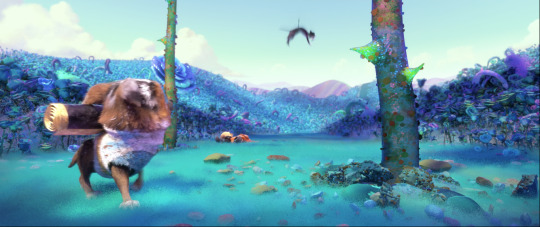
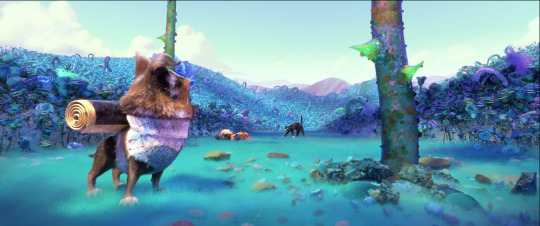
I’m really bad at story analysis lol but I wanna share my thoughts and reactions ‘cuz this movie just grew on me after watching it and I will never get tired of watching it several times. The sceneries, the action, the world building, the cinematography, the characters, and the colors used??? Oh man just please, watch this movie I DARE YOU. My favorite part? The final duel between Death and Puss! THE CONSTANT USE OF BLUE, PURPLE AND PINK COLORS IN THAT SCENE IN THE WISHING STAR. THE FIGHTING CHOREORAPHY, IT’S JUST SO BREATHTAKING.

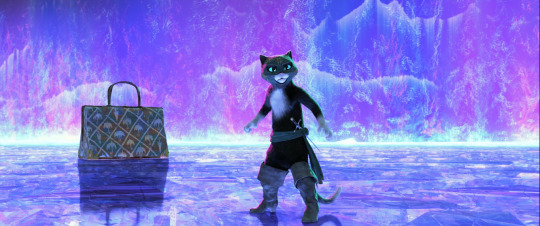
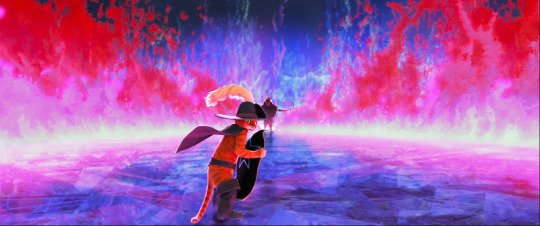
I love the amazing transformation of Puss’ character of being an arrogant and egotistical legendary hero who “laughs at the face of death” to a courageous, determined legend who finally faced his fears to fight Death himself heads on. His fearless act and him finally appreciating his remaining life got Death to give his respect for him. Somehow, Puss knows that they’ll meet again. “Hasta la Muerte”, he said. It just makes me appreciate him even more.
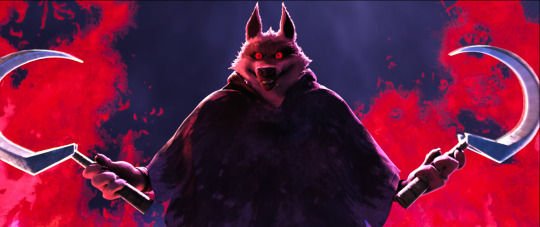
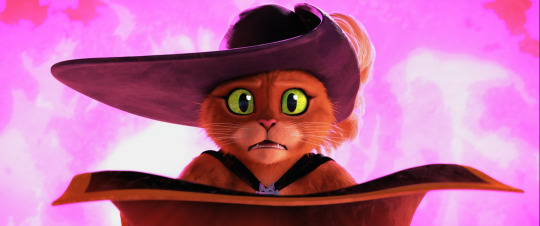
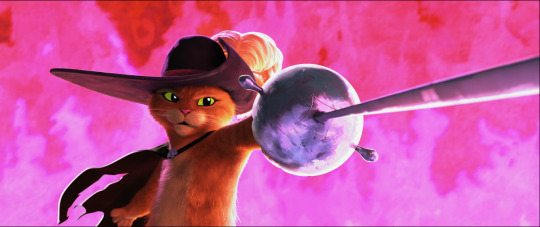
"Fight me, if you dare!"
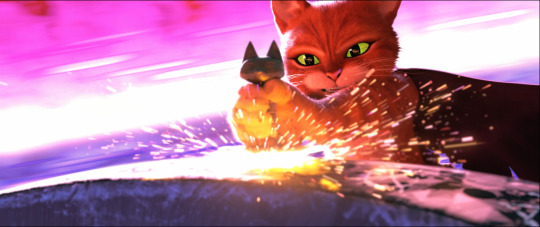

#puss in boots#puss in boots 2#puss in boots the last wish#puss in boots kitty softpaws#puss in boots spoilers#honestly this is my new hyperfixation help#the animation is so GOOD omg#hands down my favorite movie of DreamWorks so far 😩✨
12 notes
·
View notes
Text

I'm Standing on a Million Lives - Volume 15
I'm impressed that this series has made it this far. Literally no one talks about it, but there are much dumber things being published, so I guess it deserves its spot. It's definitely a mixed bag of highs and lows, but I'm mostly enjoying the ride. Still have no clue how many volumes there's going to be. No end in sight yet.
Ch. 70
Iu is goin badass mode and I'm loving it. Kinda giving Joan of Arc vibes.
The disconnect between Iu casually chopping off someone's fingers in one panel and then freaking out because she killed someone in the next was pretty wacky. Like...girl...what did you think was going to happen? Either way, I guess she got over the shock pretty quick because by the end of the chapter she's just slaughtering everyone lol.
It's kind of surprising that it took the characters this long to be worshipped for their immortality/resurrection ability. Then again, I guess living long isn't as rare in this world since there are sorcerers and dragon bishops and what not.
Ch. 71
This chapter was 100% fantasy politics. It was a struggle reading through all those silly made up names, but there were some interesting nuggets here and there.
We're jumping from one hot button to the next, first was human trafficking as seen in...many places, and next was attacks on journalistic freedom which the characters compare to recent events in Hong Kong.
I hope they give the new girl more to do than be a genki background character. She's on the cover after all! I will say her singing Immigrant Song was pretty hilarious. Certified Shrek moment.
It's kinda funny how this world/game uses community service as its goal. It's not like a twisted death game where you have to kill the other players you just have to...contribute to society lol. I guess that's what makes it interesting because the challenges take a lot more brain/strategy than a death game or RPG-style game might.
Ch. 72
Eh, this chapter was kinda messy. Overall I enjoyed it, but why did they have to bring in a damn awkward narrator every two seconds!? The mangaka does this occasionally and it drives me nuts. This story does not need a narrator and it definitely doesn't need one spelling out exactly what's going on to the reader! It took me out of the story every time. :(
I did like Iu's internal struggle and her analysis of the tricky spot she's been put in. As I've said before, this mangaka is skilled at explaining difficult concepts (politics, sociology, war strategy etc.)
Thank God they sent Glen to help Iu and not Yusuke. This way it's a child asking an adult for help and not a "dumb" woman needing a man. Also, Iu needed Glen because she's emotionally intelligent (unlike Yusuke) and was good at calming her down and validating her choice.
Ch. 73
Okay, I kinda struggled to stay awake reading this one, it was a pretty boring info dump about the politics of the area Yusuke's in and how neither side is great.
Changing someone's entire political trajectory with one song? What is this, an idol anime!? (That scene was stupid lol)
The concept of force feeding someone monster meat to turn them into a berserker is pretty chilling. Fantasy human trafficking is even more brutal than irl trafficking I guess.
I continue to really dislike the made up names of this world. In this chapter it was the Sotaga vs. the Faida. IDK why but they just don't sound like real names to me, my brain rejects them. (IDK what magic makes some made up names sound good and others sound like you threw Scrabble letters at the wall...)
Ch. 74
This chapter was all about berserkers and how they relate to all of the ongoing storylines. I find this kind of fantasy slavery pretty interesting. Instead of IRL slavery where slaves were/are used for work, they're transformed into mindless weapons. Very dark, but I could see this kind of exploitation happening if monsters were real.
Of course the main big bad, president dude is wearing a turban...as this whole arc is a thinly veiled reference to extremists in the middle east. (Just feels weird to make this fantasy world so similar to the real world).
Some pretty brutal kills in this chapter, especially Ling getting curb stomped. I do enjoy that most of the gore is stake-less so it can get extreme like that. (Well I say "gore" but the player character deaths are actually bloodless).
Damn, dat fanservice at the end there. Overall this series hasn't been that fanservicey so it feels a little weird when it's tossed in like that. The art was decent, so I ain't mad.
The over-the-top evil all around (including Yotsuya's sociopathy) is a little eye-roll worthy. Verging into cringey edgy territory a bit.
3 notes
·
View notes
Text
Another side-attraction on our road throughout spooky fairytales : the Rumpelstiltskin movie!
No, not the 1987 Cannon Movie Fairytale piece... But the 1995 horror movie!
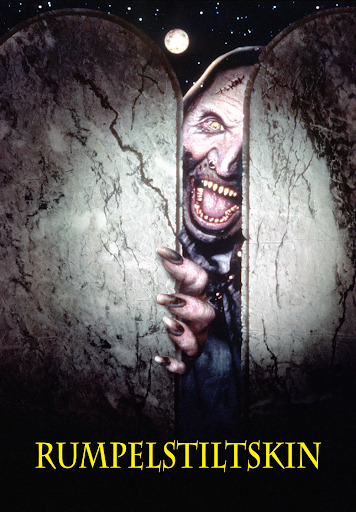
It is a little piece that most people forgot about, but it is in media story one of the first attempts at making Rumpelstiltskin a monstrous, evil fantasy creature, long before Once Upon a Time, long before Shrek: Forever After, long before The Book of Lost Things...
If you know your cult horror movies, or your B-horror movies, you'll probably understand what this movie is like and about when I'll tell you this was a Mark Jones movie, that was a followed-up to his first huge success... the movie "Leprechaun". Yep, in many ways this movie is a "Leprechaun" done again. We once again have modern (90s American) characters fighting an impish magical creature back from the past... and once again the sinister but goofy creature is driven by a single obsession (here getting ownership of a baby)... And once again you have a horror movie mixing cartoonish humor in its dark story.
This movie flopped REALLY hard on its release and was for a very long time considered as a prime example of campy horror movies (in a bad way) and of bad 90s horror movies. However, more recently the piece has been rediscovered and re-appreciated. While everybody agrees that it is not a great movie and not designed to be any serious piece of cinema, people find now that it works very well as a dark and fun gory-cartoony comedy, with a term perfectly encompassing it on the movie's page: a "dark farcical fairytale". Many call it a "so bad it is actually good" movie, and it seems the consensus is that the absurdity of the movie is (according to Wikipedia) whether what makes the movie great or bad depending on the person.
I am saying all that, taken from Wikipedia and movie reviews, because I have to admit I did not watch the movie myself. I plan to, in the future, but since I do not have much time for now, I will rely on these secondary sources and mention the existence of this movie in the list of "fairytale horror" pieces.
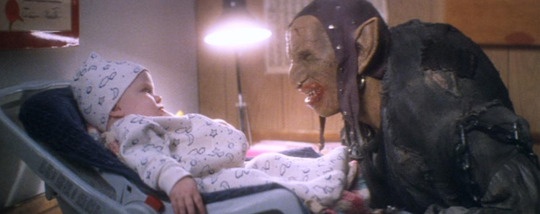
A video on Youtube that I found very informative and interesting is this one right here. It is not a review detailling the plot or the story of the movie, but as the title says an "analysis" that rather explores the origins, the context and the making of the movie - how and why it came to be as it is. This video most notably draws a comparison between this and the Leprechaun movie, with the intention of showing that, despite Leprechaun getting all the fame and Rumpelstiltskin being forgotten, the latter is actually of better quality than the former. Overall a very interesting watch.
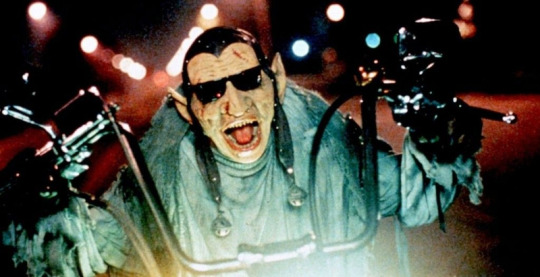
#spooky season#dark fairytales#fairytale horror#fairytale movies#horror movies#rumpelstiltskin#rumpelstiltskin 1995#leprechaun#leprechaun 1993
3 notes
·
View notes
Note
So I just read your post about the Minotaur/Astarion. And I’m positive I’m having as much Feelings as everyone else. The one thing I really do want to say, is that you shouldn’t feel bad for comparing that work to bg3!!
That’s what I find so satisfying about cultural/literary studies. So many things were seen as a sort of pop culture or unimportant work when they were first popular. For as much as people joke about Shrek, it’s been classified as a culturally transformative work!
So I feel like comparing the two is completely warranted, especially with the cultural impact that bg3 is having right now. It is so prevalent and popular, and I feel that with the depth of how the stories are written that it warrants some analysis. Especially in a few years time once things have really settled down. I can’t wait to see what other things as said about it in this vein.
(Also, thanks for the link in the originally post!! I hadn’t read that before.)
👍 swag
3 notes
·
View notes
Text
I think many people misinterpret tangleds story just because they don't think women should have short (and in their mind: ugly) hair. Rapunzel never wanted to have long hair, she needed to have long hair because otherwise it loses its healing power; a power used to make her mother look young and beautiful. The story would literally lose its meaning if rapunzel kept her hair long and beautiful. I'm too tired to write a long analysis like I made for shrek but the story is literally about the fear of aging and becoming "old and ugly" and how rapunzel becomes liberated when she "lets go" of that with the help of eugene. Rapunzel represents youth, with light and long hair, wide eyes and a naive, happy and hyperactive attitude. Gothel is scared of losing her youth, her beauty aka rapunzel. Eugene falls for rapunzel for more than her beauty, actually loves her and not her hair (her beauty), that's why he is the one who cuts her hair and makes it go "brown and ugly" or whatever. The best movies and stories are all metaphors for something else. Let rapunzel grow up you cowards
6 notes
·
View notes
Text
None of this is about authorial intent, it’s very strange that you’re creating this binary where you either follow what the author has said, or just make up whatever you want for the meaning. Did you forget that you can analyze the text itself? And that this is the primary form of literary analysis?
I’ve never heard what Shrek’s writers said about those characters, and I don’t need to, it’s blatant, commonly recycled transmisogynist tropes. The kind that anyone with a critical eye would be able to pick up quickly, and that would be very silly to just pretend doesn’t exist so you can “reinterpret” the rest of the story to be your uwu soft bean transhet romance.
But I guess this is to be expected from people who learned literary analysis from c-list YouTubers.
oh my god shrek is SUCH a trans allegory it's not even FUNNY
11K notes
·
View notes